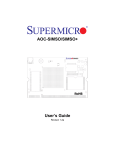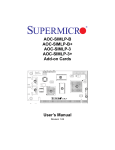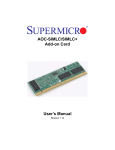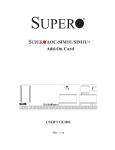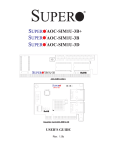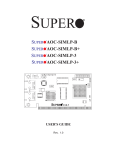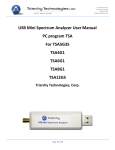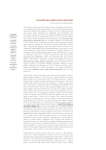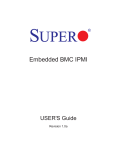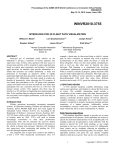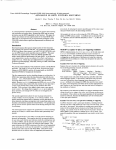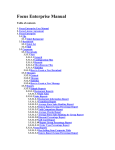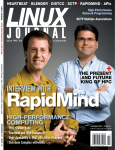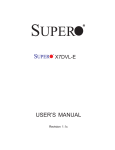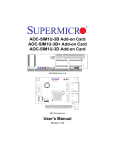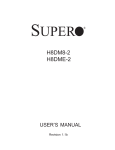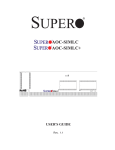Download AOC-SIM1U 1.1b.indb - Thomas
Transcript
SUPER
AOC-SIM1U/SIM1U+
Add-On Card
1
SIM1U
USER'S GUIDE
Rev. 1.1b
®
AOC-SIM1U/SIM1U+ User's Guide
The information in this User’s Manual has been carefully reviewed and is believed to be accurate.
The vendor assumes no responsibility for any inaccuracies that may be contained in this document,
makes no commitment to update or to keep current the information in this manual, or to notify any
person or organization of the updates. Please Note: For the most up-to-date version of this
manual, please see our web site at www.supermicro.com.
Super Micro Computer, Inc. ("Supermicro") reserves the right to make changes to the product
described in this manual at any time and without notice. This product, including software, if any,
and documentation may not, in whole or in part, be copied, photocopied, reproduced, translated or
reduced to any medium or machine without prior written consent.
IN NO EVENT WILL SUPERMICRO BE LIABLE FOR DIRECT, INDIRECT, SPECIAL, INCIDENTAL,
SPECULATIVE OR CONSEQUENTIAL DAMAGES ARISING FROM THE USE OR INABILITY TO
USE THIS PRODUCT OR DOCUMENTATION, EVEN IF ADVISED OF THE POSSIBILITY OF
SUCH DAMAGES. IN PARTICULAR, SUPERMICRO SHALL NOT HAVE LIABILITY FOR ANY
HARDWARE, SOFTWARE, OR DATA STORED OR USED WITH THE PRODUCT, INCLUDING THE
COSTS OF REPAIRING, REPLACING, INTEGRATING, INSTALLING OR RECOVERING SUCH
HARDWARE, SOFTWARE, OR DATA.
Any disputes arising between manufacturer and customer shall be governed by the laws of Santa
Clara County in the State of California, USA. The State of California, County of Santa Clara shall
be the exclusive venue for the resolution of any such disputes. Super Micro's total liability for
all claims will not exceed the price paid for the hardware product.
FCC Statement: This equipment has been tested and found to comply with the limits for a Class
A digital device pursuant to Part 15 of the FCC Rules. These limits are designed to provide
reasonable protection against harmful interference when the equipment is operated in a commercial
environment. This equipment generates, uses, and can radiate radio frequency energy and, if not
installed and used in accordance with the manufacturer’s instruction manual, may cause harmful
interference with radio communications. Operation of this equipment in a residential area is likely
to cause harmful interference, in which case you will be required to correct the interference at your
own expense.
California Best Management Practices Regulations for Perchlorate Materials: This Perchlorate
warning applies only to products containing CR (Manganese Dioxide) Lithium coin cells. “Perchlorate
Material-special handling may apply. See www.dtsc.ca.gov/hazardouswaste/perchlorate”
WARNING: Handling of lead solder materials used in this
product may expose you to lead, a chemical known to
the State of California to cause birth defects and other
reproductive harm.
Manual Revision 1.1b
Release Date: June 13, 2008
Unless you request and receive written permission from Super Micro Computer, Inc., you may not
copy any part of this document.
Information in this document is subject to change without notice. Other products and companies
referred to herein are trademarks or registered trademarks of their respective companies or mark
holders.
Copyright © 2008 by Super Micro Computer, Inc.
All rights reserved.
Printed in the United States of America
1-2
Chapter 1: Introduction
Table of Contents
Chapter I: Introduction .............................................................................1-4
1.1 Overview ..................................................................................................... 1-4
1.2 IPMI Version 2.0 ......................................................................................... 1-5
1.3 Product Features ........................................................................................ 1-5
1.4 Checklist .................................................................................................... 1-5
1.5 An Important Note to the User ................................................................... 1-5
1.6 Contacting Supermicro ............................................................................... 1-6
1.7 Returning Merchandise for Service .......................................................... 1-7
Chapter 2: Technical Specifications and Hardware Installation .......... 2-1
2.1 The Configuration of the AOC-SIM1U/SIM1U+ & the AOC-USB2RJ45 .... 2-1
2.2 AOC-SIM1U/SIM1U+ Connector and Jumper Locations .......................... 2-2
2.2.1 Front Components on the AOC-SIM1U(+) .............................................. 2-2
2.2.2 The Dedicated LAN LED on the AOC-USB2RJ45 .................................. 2-2
2.2.3 Front Connectors and LED Indicators ..................................................... 2-3
2.2.4 Dedicated LED Indicators ........................................................................ 2-4
2.2.5 Rear Components on the AOC-SIM1U(+) ............................................... 2-5
2.2.6 Rear LED Indicators ................................................................................ 2-5
2.3 Block Diagram ............................................................................................ 2-6
2.4 Installing the AOC-SIM1U(+) ...................................................................... 2-7
2.4.1 Safety Guidelines .................................................................................... 2-7
2.4.2 SIM1U Slot Locations .............................................................................. 2-8
Chapter 3: Software Application and Usage .......................................... 3-1
3.1 Home Page................................................................................................. 3-3
3.2 Functions Listed On the Home Page ......................................................... 3-5
3.2.1 Remote Control ....................................................................................... 3-5
3.2.2 Virtual Media ............................................................................................ 3-7
3.2.3 System Health ........................................................................................3-11
3.2.4 User Management ................................................................................. 3-17
3.2.5 KVM Settings ......................................................................................... 3-21
3.2.6 Device Settings...................................................................................... 3-25
3.2.7 Maintenance .......................................................................................... 3-38
3.3 Remote Console Main Page .................................................................... 3-42
3.3.1 Remote Console Options ...................................................................... 3-43
Chapter 4: Frequently Asked Questions ................................................ 4-1
1-3
AOC-SIM1U/SIM1U+ User's Guide
Chapter 1
Introduction
This user's guide is written for system integrators, PC technicians and
knowledgeable PC users who intend to integrate Supermicro's unique IPMI 2.0
Management Utility with support of KVM-over-LAN () into their systems. It provides detailed information for the application and use of the AOC-SIM1U/SIM1U+
that supports remote access for system monitoring, diagnosis and management.
With the most advanced technologies built-in, the AOC-SIM1U/SIM1U+ offers a
complete, efficient, and cost-effective remote server management.
(Note: KVM-over-LAN is only for the AOC-SIM1U+ only.)
1.1 Overview
The AOC-SIM1U/SIM1U+ is a highly efficient, highly compatible and easy-to-use
IPMI card that allows the user to take advantage of the BMC, a baseboard management controller installed on a server motherboard and the IPMIView, an IPMIcompliant management application software loaded in a PC, to provide serial links
between the main processor and other system components, allowing for network
interfacing via remote access. With an independent Raritan KIRA100 processor
built-in, the AOC-SIM1U/SIM1U+ provides the user with a solution to ease the complex and expensive systems, allowing an administrator to access, monitor, diagnose
and manage network interfacing anywhere, anytime.
1.2 IPMI Version 2.0
The AOC-SIM1U/SIM1U+ supports the functionality of IPMI Version 2.0. The key
features include the following:
•
Supports IPMI 2.0 over LAN
•
Supports Serial over LAN
•
Supports Virtual Media over LAN
•
Supports KVM over LAN (For the AOC-SIM1U+ only)
•
Supports LAN Alerting-SNMP Trap
•
Supports Event Log
•
Offers OS (Operating System) Independency
•
Provides remote Hardware Health Monitoring via IPMI. Key features include
the following:
•
Temperature monitoring
•
Fan speed monitoring
•
Voltage monitoring
•
Power status monitoring, chassis intrusion monitoring
•
Remote power control to power-on, power-off or reboot a system
1-4
Chapter 1: Introduction
•
•
Remote access to text-based, graphic-based system information,
including BIOS configurations and OS operation information (KVM)
•
Remote management of utility/software applications
Provides Network Management Security via remote access/console redirection. Key features include:
•
•
User authentication enhancement
Encryption support enhancement, allowing for password configuration security to protect sensitive data transferring via Serial over
LAN
•
Supports the following Management tools: IPMIView, CLI (Command Line
Interface) and Webengine
•
Supports RMCP & RMCP protocols
1.3. Product Features
(a) The AOC-SIM1U/SIM1U+ Series: (IPMI 2.0 with a Dedicated LAN)
•
•
•
•
Slim size (4.6" W x 1.3" H) (116.84 mm W x 25.41 mm H)
Supports IPMI over LAN
Supports 1U and above
Supports dedicated LAN
1.4 Checklist
If your shipping package came with missing or damaged parts, please contact
Supermicro's Tech. Support. Please refer to the following checklist when contacting
us.
i. AOC-SIM1U/SIM1U+
ii. Bracket: One bracket (SKT-0240L, including the AOC-USB2RJ45 Add-On Card,
the CBL-0165L Cable, Full and Low Profile I/O Brackets.) (The SKT-0240L is
included in the SIM1U+ shipping package only.)
iii. CDR-SIMIPMI: One Installation CD
iv. White Box with Correct Barcode Label (showing AOC-SIM1U/SIM1U+).
1.5 An Important Note to the User
The graphics shown in this user's guide were based on the latest PCB Revision
available at the time of publishing of this guide. The SIM1U/SIM1U+ card you’ve
received may or may not look exactly the same as the graphics shown in this
user's guide.
1-5
AOC-SIM1U/SIM1U+ User's Guide
1.6
Contacting Supermicro
Headquarters
Address:
Super Micro Computer, Inc.
980 Rock Ave.
San Jose, CA 95131 U.S.A.
Tel:
+1 (408) 503-8000
Fax:
+1 (408) 503-8008
Email:
[email protected] (General Information)
[email protected] (Technical Support)
Web Site:
www.supermicro.com
Europe
Address:
Super Micro Computer B.V.
Het Sterrenbeeld 28, 5215 ML
's-Hertogenbosch, The Netherlands
Tel:
+31 (0) 73-6400390
Fax:
+31 (0) 73-6416525
Email:
[email protected] (General Information)
[email protected] (Technical Support)
[email protected] (Customer Support)
Asia-Pacific
Address:
Super Micro Computer, Inc.
4F, No. 232-1, Liancheng Rd.
Chung-Ho 235, Taipei County
Taiwan, R.O.C.
Tel:
+886-(2) 8226-3990
Fax:
+886-(2) 8226-3991
Web Site:
www.supermicro.com.tw
Technical Support:
Email:
[email protected]
Tel:
886-2-8226-1900
1-6
Chapter 1: Introduction
1.7
Returning Merchandise for Service
A receipt or copy of your invoice marked with the date of purchase is
required before any warranty service will be rendered. You can obtain
service by calling your vendor for a Returned Merchandise Authorization
(RMA) number. When returning to the manufacturer, the RMA number
should be prominently displayed on the outside of the shipping carton, and
mailed prepaid or hand-carried. Shipping and handling charges will be
applied for all orders that must be mailed when service is complete.
For faster service, RMA authorizations may be requested online (http://
www.supermicro.com/support/rma/).
Whenever possible, repack the add-on card in the original Supermicro box,
using the original packaging materials. If these are no longer available, be
sure to pack the add-on card in an anti-static bag and inside the box. Make
sure that there is enough packaging material surrounding the add-on card
so that it does not become damaged during shipping.
This warranty only covers normal consumer use and does not cover damages incurred in shipping or from failure due to the alteration, misuse,
abuse or improper maintenance of products.
During the warranty period, contact your distributor first for any product
problems.
1-7
Chapter 2: Technical Specifications and Installation
Chapter 2
Technical Specifications and Hardware
Installation
2.1 Configuring the AOC-SIM1U/SIM1U+ and
the AOC-USB2RJ45 Add-On Cards
The AOC-SIM1U/SIM1U+ Add-On Card is connected to a Dedicated LAN Ethernet
port located on the AOC-USB2RJ45 Add-On Card via an SMC Proprietary cable
(CBL-0165L) for External LAN access. One end of the CBL-0165L cable is connected to the mini USB connector (J3) located on the AOC-SIM1U(+) card and the
other end to that of the AOC-USB2RJ45 card. There are two LEDs located on the
LAN port to indicate network links and activities. Refer to the picture below for the
configuration.
*Note 1: You can also use LAN1 on the motherboard if you do not need the dedicated LAN support. However, dedicated LAN is recommended for better graphic
support when the KVM feature is used.
*Note 2: The SKT-0240L is included in the SIM1U+ shipping package only.
Mini USB
Connector (J3)
Bracket
Dedicated
Ethernet
(LAN) Port
AOC-SIM1U(+)
Mini USB
Connector
CBL-0165L Cable
AOC-USB2RJ45
LAN LEDs
The SKT-0240L
(*Note 2 above)
2-1
AOC-SIM1U/SIM1U+ User's Guide
2.2 AOC-SIM1U/SIM1U+ Connector and Jumper
Locations
Front View
JP5
1
6
1
V-RAM
5
D3
SDRAM
2
3
Transformer
SDRAM
2
SIM1U
(*Note: " ", " ", or " " indicates Pin 1.)
2.2.1 Front Components on the AOC-SIM1U(+)
1.
2.
3.
4.
5.
6.
V-RAM (64Mb/166MHz)
SDRAM (128Mb/133MHz)
Transformer
J3: Mini USB 9-pin Connector (*Note)
JP5: Kira 100 Processor Reset (*Note)
D3: Standby Power LED Indicator
2.2.2 The Dedicated LAN LED Indicators on the AOC-USB2RJ45
8. Dedicated LAN LED Indicators
(*Note)
(*Note: See Pages 2-3, 2-4 for details)
2-2
8
4
4
J3
Chapter 2: Technical Specifications and Installation
2.2.3 Front Connector and LED Indicators
#4. J3: Mini USB Connector
There is a mini USB connector (J3) located on the
AOC-SIM1U/SIM1U+ and another mini USB connector is located on the AOC-USB2RJ45. Use Cable
CBL-0165L to connect the two mini USB connectors
on both add-on cards for external LAN access. Refer
to Page 2-1 for details. See the table at right for the
pin definitions.
AOC-SIM1U(+)
Mini USB
Connector
Mini USB Pin Definitions
(J3)
Pin#
Definition
1
Eth-TX_H
2
Eth-TX_L
3
Phy-100
4
Eth-RX_L
5
Eth-RX_H
6
Phy-ACT
7
Dedicated LANDetected
8
3V-duall
9
Ground
CBL-0165L Cable
(*Note)
AOC-USB2RJ45
Dedicated LAN
port
The SKT-0240L
(*Note below)
#5. JP5: RISC CPU Reset
JP5 is used to reset the Kira 100 Processor, NIC,
and R.T. Close Pin 1 and Pin 2 to enable this
function.After a reset or AC power-on, the AOCSIM1U(+) will automatically detect if a cable (CBL0165L) is connected. If a cable is not detected,
the AOC-SIM1U(+) will transfer the "Remote
RISC CPU Reset
Setting
Description
Open
Disabled (*Default)
Close
Enabled
Control" Function to LAN1 on the motherboard.
If a cable is detected, the AOC-SIM1U(+) will use
the dedicated LAN attached to it via the mini USB
connector to manage motherboard activities via
Remote Console. See the table on the right for
jumper settings.
*Note: The SKT-0240L is included in the SIM1U+ shipping package only.
2-3
AOC-SIM1U/SIM1U+ User's Guide
#7. D3: Standby Power LED Indicator
When this LED is on, the standby power is
on. Be sure to remove power cables before
installing or removing components.
2.2.4 Dedicated LAN LED Indicators
#8. Dedicated LAN LED Indicators
There are two LAN LED Indicators located
on the (Dedicated) LAN port on the AOCUSB2RJ45 Add-On Card. The green LED
indicates activity, while the power LED may
be green or off to indicate the speed of the
Ethernet connection. See the tables on the
right for more information.
Activity
LED
Link LED
GLAN Activity Indicator
Color
Status
Definition
Amber
Flashing
Active
GLAN Link Indicator
2-4
LED Color
Definition
Off
No Connection or 10 Mbps
Green
100 Mbps
Chapter 2: Technical Specifications and Installation
Rear View
Kira 100 Processor
4
3
Heartbeat LED
2
1
PHY LAN
Flash Memory
2.2.5 Rear Components on the AOC-SIM1U(+)
Rear Side Components
1.
2.
3.
4.
Raritan's Kira 100 RISC System on Chip
Flash Memory
PHY LAN
Heartbeat LED
2.2.6 Rear Side LED Indicators
#4 Heartbeat LED Indicator
Heartbeat LED, located on the rear side
of the AOC-SIM1U(+) card, indicates the
functionality and activity of the add-on
card. Heartbeat LED blinks when the
AOC-SIM1U(+) is active. However, when
the Linux OS and the drivers are being
loaded after each AC power-on or reset,
Heartbeat LED is off for about a minute.
Then, Heartbeat LED will be on again to
indicate that the AOC-SIM1U(+) is active.
See the table on the right for details.
2-5
Heartbeat LED
On (Blinking)
SIM1U(+): active
Off (for 1 minute)
Loading Firmware
Off (Continuously)
SIM1U is not active
AOC-SIM1U/SIM1U+ User's Guide
2.3 Block Diagram
5
4
3
2
1
UART Interface
4
4
USB Interface
KIRA100
FML Interface
DVO interface
GPIO24
RMII
CABLE detection (Lo active)
3
Mother Board SMDATA
Ethernet PHY
Mother Board SMCLK
Mother Board SMALT#
mini USB cable
PIN 7
miniUSB
3
IPMI-200 Connector
LPC Interface
SIM1U only
RJ45
Dedicated LAN
2
2
1
1
SUPER
Title
Size
5
4
3
2-6
2
2051 Junction Ave. San Jose CA, 95131
TEL : (408) 895-2000
®
CONFIDENTIAL - DO NOT DUPLICATE
Block Diagram
Document Number
SIM1U
Date:Wednesday, August 23, 2006
Rev
1.02B
Sheet
1
2
of
9
Chapter 2: Technical Specifications and Installation
2.4 Installing the AOC-SIM1U/SIM1U+
2.4.1 Safety Guidelines
To avoid personal injury and property damage, please carefully
follow all the safety steps listed below when installing the AOCSIM1U(+) into your system.
ESD Safety Guidelines
Electro-Static Discharge (ESD) can damage electronic components. To prevent damage to your system, it is important to handle it very carefully. The following measures
are generally sufficient to protect your equipment from ESD.
•
Use a grounded wrist strap designed to prevent static discharge.
•
Touch a grounded metal object before removing a component from the antistatic
bag.
•
Handle the add-on card by its edges only; do not touch its components, peripheral
chips, memory modules or gold contacts.
•
When handling chips or modules, avoid touching their pins.
•
Put the card and peripherals back into their antistatic bags when not in use.
General Safety Guidelines
•
Always disconnect power cables before installing or removing any components
from the computer.
•
Disconnect the power cable before removing any cable from the add-on card.
•
Make sure that the SIM1U(+) add-on card is securely seated in the SIM1U slot to
prevent damage to the system due to power shortage. For SIM1U slot locations,
please refer to Section 2.4.2.
SMC Motherboards with SIM1U(+) support
The following Supermicro's motherboards support the AOC-SIM1U(+).
1. The X7DB8/X7DBE/X7DB8+/X7DBE+/X7DB8-X/X7DBE-X/X7DB3 Series
2. The X7DA8/X7DAE/X7DVA-8/X7DVA-E/X7DVL-3/i Series (*Note)
3. The X7DVL-E Series
4. The PDSM4+/PDSME+ Series
(*Note: KVM-over-LAN is not supported by the X7DA8/X7DAE/X7DVL-3/i.)
2-7
AOC-SIM1U/SIM1U+ User's Guide
2.4.2 SIM1U Slot Locations
To properly use the AOC-SIM1U(+), be sure to install it in the right slot. Refer to
the MB layouts below for SIM1U slot locations.
1. The X7DB8/X7DBE/X7DB8+/X7DBE+/X7DB8-X/X7DBE-X/X7DB3 Series and
2. The X7DA8/X7DAE/X7DVA-8/X7DVA-E/X7DVL-3/i Series (*Note)
SIM1U(+) Slot (Slot 7)
3. The X7DVL-E
SIM1U(+) Slot
4. The PDSM4+/PDSME+ Series
SIM1U(+) Slot
(*Note: KVM-over-LAN is not supported by
the X7DA8/X7DAE/X7DVL-3/i.)
2-8
Chapter 3: Software Application and Usage
Chapter 3
Software Application and Usage
With an independent I/O processor embedded in Raritan's Kira 100 RISC System
Chip, the AOC-SIM1U/SIM1U+ Add-On Card allows the user to access, monitor,
manage and interface with systems that are in remote locations via LAN. (See the
note on Page 3-2.) The necessary utilities for the access and configuration of the
add-on card are included on the Supermicro bootable CDs that came with your
card. This section provides information on the configuration and the access of the
IPMI card on the network.
Using the IPMICFG Utility to Configure IP/MAC Addresses and other
IPMI Network Settings
1. Run the ipmicfg utility from the bootable CD that came with your shipment.
2. Refer to the table below to configure the IP/MAC addresses.
Board
IPMI
MAC
IP
Communication through
X7 Series with LAN
82563EB, 82575
SIMLC
IPMI Card
Available
IP/DHCP
LAN1 on MB
X7 Series with LAN
82573
SIMLC
LAN1
Available
IP
LAN1 on MB
H8 DDR2 Memory
SIM1U
IPMI Card
Available
IP/DHCP
Dedicated LAN
H8QM3/i-x
SIM1U
IPMI Card
Available
IP/DHCP
Dedicated LAN
LAN1
LAN1
LAN1 on MB
LAN1 on MB
3. Follow the instructions given in the Readme.txt file to configure Gateway IP/Netmask IP addresses, to enable/disable DHCP and to configure other IPMI settings.
Note 1: The Readme.txt file is included in the CD that came with your shipment. A
copy of the Readme.txt file, dated 07/05/2007, is also included below.
IPMICFG Version 1.07 (Build 080209) Copyright 2007 SuperMicro Computer Inc.
Usage: IPMICFG params (Example: IPMICFG -m 192.168.1.123)
-m
Show IP and MAC
-m IP
Set IP (format: ###.###.###.###)
-a MAC
Set MAC (format: ##:##:##:##:##:##)
-k
Show Subnet Mask
-k Mask Set Subnet Mask (format: ###.###.###.###)
-dhcp on Enable the DHCP
-dhcp off Disable the DHCP
-g
Show Gateway IP
-g IP
Set Gateway IP (format: ###.###.###.###)
-r
BMC cold reset
-garp on Enable the Gratuitous ARP
-garp off Disable the Gratuitous ARP
-fd
Reset to the factory default
3-1
AOC-SIM1U/SIM1U+ User's Guide
To Access the SIM1U/SIM1U+ Card from a Computer Using the H8QM32(+)/H8QMi-2(+) Motherboards
A. Using the Onboard LAN1 Connection
1. Choose a computer that is connected to the same network and open the
IPMIView utility.
2. Go to File>New>System. Type System Name, IP Address of LAN1, Description
in the appropriate blanks and press the <Enter> key.
3. Select the system from the IPMI Domain. Type the Login ID and Password in
the appropriate blanks to log into the IPMIView utility.
B. Using the Dedicated LAN
1. Choose a computer that is connected to the same network and open the
browser.
2. Type in the IP address of each server that you want to connect to in the ad-dress
bar in your browser.
3. Once the connection is made, the Log In screen as shown below will
display.
To Log In
Once you are connected to the remote server, the following Log In screen
displays.
1. Type in your Username in the "Username" box.
2. Type in your Password in the "Password" box and click on "Login."
(Note: The default username is ADMIN. The default password is ADMIN.)
3. The Home Page will display as follows:
Note: KVM-over-LAN is available on the AOC-SIM1U+ only. All features and options
related to the functionality of KVM-over-LAN are supported by the AOC-SIM1U+
only. In addition, KVM-over-LAN is not supported by the following motherboards:
1. X7DA8/X7DAE
2. X7DVL-3/X7DVL-i.
3-2
Chapter 3: Software Application and Usage
3.1 Home Page
Home
Remote Console Screen
Logout
4
2
1
Function Keys
Console
9
3
5
6
7
8
3.1.1 Buttons from the Home Page
1
Home: Click this icon to return to the Home Page.
2
Console: Click this icon to go to the Remote Console Screen.
3
Remote Console Screen: Displayed in the window is Remote Console
Screen. Click on this window to go to the Remote Console Screen.
4
Logout: Click on this icon to log out.
5
Refresh: Click on this icon to refresh the screen of the remote console preview.
6
Power On: Click on this icon to power on the system of the
remote host.
7
Power Down: Click on this icon to power down the system
of the remote host.
8
Reset: Click on this icon to reset the remote host.
3-3
AOC-SIM1U/SIM1U+ User's Guide
3.1.2 Function Keys from the Home Page
9
1
2
3
4
5
6
7
Click on these function keys to use the functions as specified below.
1. Remote Control: Click on this icon for remote access
and management of Video Console Redirection.
2. Virtual Media: Click on this icon to use virtual remote
media devices.
3. System Health: Click on this icon to view and manage
health monitoring for remote systems
4. User Management: Click on this icon for User Management.
5. KVM Settings: Click on this icon to configure keyboard, Video and mouse settings.
6. Device Settings: Click on this icon to configure device
settings.
7. Maintenance: Click on this icon to access, diagnose
and manage hardware devices
(Note: Please see the next page for details on the functions specified above.)
3-4
Chapter 3: Software Application and Usage
3.2 Functions Listed on the Home Page
3.2.1. Remote Control
Click on the icon of Remote Control to activate its submenus-KVM Console and
Remote Power as listed below.
a. KVM Console
Click on this item to configure keyboard, mouse or video settings for the remote
host.
Remote Console Screen
1
2
3
4
1
Explanation of Functions
In the Single/Synchronized Mouse Mode, this cursor indicates the system that is currently active. For the Double Mouse mode, this is the cursor for the remote host.
2
This second mouse cursor only appears in the Double Mouse Mode.
This cursor represents the local mouse.
3
This icon indicates the availability of Keyboard and Mouse.
4
This icon indicates the number of networks (users) that are connected
via Console Redirection. (The number of figure icons indicates the number of users connected.)
3-5
AOC-SIM1U/SIM1U+ User's Guide
b. Remote Power
Click on this item to configure the power settings for Remote Console as shown
below.
Remote Power Screen
1
2
3
Explanation of Functions
1
Power On: Click on this icon to power on the remote host.
2
Power Down: Click on this icon to power down the remote
host.
3
Reset: Click on this icon to reset the remote host.
3-6
Chapter 3: Software Application and Usage
3.2.2. Virtual Media
Click on the Virtual Media icon on the Home Page to activate its submenus-Floppy
Disk, CD-ROM, Drive Redirection and Options as listed below.
a. Floppy disk
Floppy Disk Screen
2
3
1
4
5
6
7
Explanation of Functions
Floppy Disk: Click on this function key to upload the data
1
stored in the local floppy disk image to the remote host.
2
Active Image (Drive1): This window displays the data
that has been uploaded to Drive 1 of the remote host.
3
Active Image (Drive2): This window displays the data
that has been uploaded to Drive 2 of the remote host.
4
5
6
7
Floppy Image Upload: This option allows the user to upload the floppy image as "floppy" located in the remote
host. The floppy image uploaded shall be in the binary
format with a maximum size of 1.44MB. It will be loaded
to the Supermicro SIMLP card and will be emulated to the
host as a USB device.
Virtual Drive: Select a drive in the remote host as a destination drive for you to upload your image data.
Floppy Image File: Click on "Browse" to preview and
select the files that you wish to upload to the host drive
selected.
Upload: Once the correct file name appears in the box,
click Upload to upload the floppy image to the drive specified in the remote host.
3-7
AOC-SIM1U/SIM1U+ User's Guide
b. CD-ROM Image
CD-ROM Image Screen
2
3
1
4
5
6
7
8
9
10
Explanation of Functions
1
2
3
4
CD-ROM image: Click on this function key to share data
stored in your local CD-ROM drive with other users in the
remote host through the Windows Share application via
USB.
Active Image (Drive1): This window displays the file
name of the data currently active in host Drive 1.
Active Image (Drive2): This window displays the file
name of the data currently active in host Drive 2.
Image on Windows Share: This option allows the user to
configure Windows Share settings. It allows you to decide
how you want to share the CD-ROMISO Image file with
users in the remote host.
5
Virtual Drive: Specify the drive that you want to share
your data with in the remote host.
6
Share Host: Key in the IP Address or the name of the
system you wish to share data with via Windows Share.
7
8
9
10
Share Name: Key in the name of the system you wish to
share data with in the remote host.
Path to Image: Key in the location of source files that
you wish to share via Windows Share.
User/Password (Optional): Key in the Username and
password for the person to access the data that you want
to share and click "Set" to enter your selections.
3-8
Chapter 3: Software Application and Usage
c. Drive Redirection
Drive Redirection Screen
2
3
1
4
5
6
7
8
Explanation of Functions
Drive Redirection: Click on this function key to make lo1
cal drives accessible for other users via console redirection. This function allows you to share your local drives
(Floppy, CD-ROM and HDDs) with users in the remote
systems.
2
Active Image (Drive1): This window displays the file
name of the data currently active in host Drive 1.
3
Active Image (Drive2): This window displays the file
name of the data currently active in host Drive 2.
4
5
6
7
8
Drive Redirection: Use this window to configure Drive
Redirection settings.
Disable Drive Redirection: Check the box to disable
Drive Redirection. Once this function is disabled, local
drives will not be accessible for other users in remote
host.
Force Read Only: Check this box to allow the data
stored in local drives to be read in a remote system, but it
cannot be overwritten to ensure data integrity and system
security.
Apply: Once you've configured your settings, click "Apply" to enter your settings.
Reset Default: You can also key in your own setting values and re-set these values as "default" by clicking on
this icon to reset the defaults.
3-9
AOC-SIM1U/SIM1U+ User's Guide
d. Virtual Media Options
Virtual Media Options Screen
2
4
1
Explanation of Functions
1
2
3
4
Options: Click on this function key to activate the Virtual
Media sub-menu.
Virtual Media Options: Use this option to disable or enable USB MASS storage in the remote host. Check this
box to disable the function of Virtual Media Options to
prevent data stored in a local drive from being accessed,
or uploaded by the user in the remote host. The default
setting is "enabled."
Apply: Once you've checked the box, click "Apply" to enter this value.
Reset to Defaults: If you want to set "Disabled" as the
default setting for the item-Virtual Media Options, click
on this icon.
3-10
Chapter 3: Software Application and Usage
3.2.3. System Health
Click on the System Health icon on the Home Page to activate its submenus: Chassis Control, Monitor Sensor, System Event Log and Alert settings as listed below.
System Health Screen
a. Chassis Control
Chassis Control Screen
2
1
3
1
2
Chassis Control
Chassis Control: Click on this function key to access Health Monitoring information
on the remote chassis. The items monitored include 1. Chassis Information 2. Power
Control.
Chassis Information:
The following remote chassis information is included:
Power Is: This indicates if the system is on or off for the remote host.
Power On Counter: If power is on, then the counter indicates the length of time the
power has been turned on.
Last Restart Cause: This item states the reason why the host system is restarted if
the system has been turned off.
Refresh: Click the Refresh button to update "Chassis Information" as shown in
Window 2.
3-11
AOC-SIM1U/SIM1U+ User's Guide
3
Power Control
The following Power Control items are included:
Refresh: Click on this icon to refresh the screen of the remote host.
Power On: Click on this icon to power on the system for the
remote host.
Power Down: Click on this icon to power down the system
for the remote host.
Power Cycle: Click on this icon to power down the system
for the remote host and turn it back on later.
Reset: Click on this icon to reset the remote console.
3-12
Chapter 3: Software Application and Usage
b. Monitor Sensors
Home
Home
Monitor Sensors Screen
Console
Logout
Remote Control
KVM Console
Remote Power
Monitoring Sensors
Virtual Media
Floppy Disk
CD-ROM Image
Drive Redirection
Options
System Health
Chassis Control
Monitor Sensors
System Event Log
Alert Settings
1
User Management
Change Password
Users & Groups
Permissions
KVM Settings
User Console
Keyboard/Mouse
Device Settings
Network
Dynamic DNS
Security
Certificate
Date/Time
Event Log
SNMP Settings
Maintenance
Device Information
Event Log
Update Firmware
Unit Reset
1
Sensor Type
Sensor Name
Sensor Status
Temperature
CPU1 Temp A
No reading
Sensor Reading
Temperature
CPU2 Temp A
Ok
47 degrees C
Temperature
CPU1 Temp B
Ok
35 degrees C
Temperature
CPU2 Temp B
No reading
Temperature
Sys Temp
Ok
Voltage
CPU1 Vcore
Below lower non-recoverable threshold 0 (+/- 0.004) Volts
Voltage
CPU2 Vcore
Ok
1.288 (+/- 0.004) Volts
Voltage
3.3V
Ok
3.264 Volts
Voltage
5V
Ok
4.872 (+/- 0.012) Volts
Voltage
12V
Ok
11.904 (+/- 0.048) Volts
Voltage
-12V
Below lower non-recoverable threshold -3.800 (+/- -0.050) Volts
Voltage
1.5V
Ok
1.456 (+/- 0.008) Volts
Voltage
5VSB
Ok
4.848 (+/- 0.012) Volts
Voltage
VBAT
Ok
3.184 (+/- 0.008) Volts
Fan
Fan1/CPU
Below lower non-recoverable threshold 0 RPM
Fan
Fan2/CPU
Below lower non-recoverable threshold 0 RPM
Fan
Fan3
Ok
Fan
Fan4
Below lower non-recoverable threshold 0 RPM
Fan
Fan5
Below lower non-recoverable threshold 0 RPM
Fan
Fan6
Below lower non-recoverable threshold 0 RPM
44 degrees C
3750 RPM
Physical Security Chassis Intrusi
Below lower non-critical threshold
0 unspecified
Power Supply
Power Fail
Ok
0 unspecified
Module / Board
CPU0 Internal E Ok
0 unspecified
Module / Board
CPU1 Internal E Ok
0 unspecified
Module / Board
CPU Overheat
Ok
0 unspecified
Module / Board
Thermal Trip0
Ok
0 unspecified
Module / Board
Thermal Trip1
Ok
0 unspecified
Monitoring Sensor: Click on this function key to display the following Health Monitoring Information shown in the following table:
http://192.168.1.200/home.asp6/8/2006 3:39:33 PM
3-13
AOC-SIM1U/SIM1U+ User's Guide
Health Monitoring Sensor Information on the Remote Host
Temperature Monitoring
Voltage Monitoring
Fan Control
Physical Security
Module/Board CPU0
Internal E.
Module/Board CPU1
Internal E.
Module/Board CPU
Overheat
CPU1 Temperature
(Temp A, Temp B)
CPU2 Temperature
(Temp A, Temp B)
System Temperature
CPU1 VCore
CPU2 VCore
3.3V
5V, 5VSB
+12V, -12V
1.5V
VBAT
Fan1/CPU Fan
Fan2/CPU Fan
Fan 3 – Fan 6
Chassis Intrusion
Temp A: CPU1 Core1 Temperature, Temp B: CPU1
Core2 Temperature,
Temp A: CPU2 Core1 Temperature, Temp B: CPU2
Core2 Temperature,
CPU1 Vcore: CPU1 Core Voltage
CPU2 Vcore: CPU2 Core Voltage
5VSB: 5V Standby
VBAT: Battery Voltage
System Fans/Chassis Fans
When the CPU temperature exceeds this preset
temperature, the overheat LED or alert will be
triggered, the CPUs will slow down, the CPU fans
will be in the full speed mode.
When the system temperature exceeds this preset
temperature, the overheat LED or alert will be
triggered, and the cooling fans will be in the full
speed mode to prevent system overheat.
Module/Board Thermal
Trip
3-14
Chapter 3: Software Application and Usage
c. System Event Log
System Event Log Screen
Home
Home
Console
Logout
Remote Control
KVM Console
Remote Power
System Event Log
Event Type
Virtual Media
Floppy Disk
CD-ROM Image
Drive Redirection
Options
System Health
Chassis Control
Monitor Sensors
System Event Log
Alert Settings
User Management
Change Password
Users & Groups
Permissions
KVM Settings
User Console
Keyboard/Mouse
Device Settings
Network
Dynamic DNS
Security
Certificate
Date/Time
Event Log
1
Date
Time
Source
Description
Direction
SEL record 02 Pre-Init
00:01:04 Fan6
Lower Non-recoverable going low Assertion Event
SEL record 02 Pre-Init
00:01:04 Fan6
Lower Critical going low
Assertion Event
SEL record 02 Pre-Init
00:01:04 Fan6
Lower Non-critical going low
Assertion Event
SEL record 02 Pre-Init
00:01:04 Fan5
Lower Non-recoverable going low Assertion Event
SEL record 02 Pre-Init
00:01:04 Fan5
Lower Critical going low
Assertion Event
SEL record 02 Pre-Init
00:01:04 Fan5
Lower Non-critical going low
Assertion Event
SEL record 02 Pre-Init
00:01:04 Fan4
Lower Non-recoverable going low Assertion Event
SEL record 02 Pre-Init
00:01:04 Fan4
Lower Critical going low
Assertion Event
SEL record 02 Pre-Init
00:01:04 Fan4
Lower Non-critical going low
Assertion Event
SEL record 02 Pre-Init
00:01:04 Fan2/CPU
Lower Non-recoverable going low Assertion Event
SEL record 02 Pre-Init
00:01:04 Fan2/CPU
Lower Critical going low
Assertion Event
SEL record 02 Pre-Init
00:01:04 Fan2/CPU
Lower Non-critical going low
Assertion Event
SEL record 02 Pre-Init
00:01:04 Fan1/CPU
Lower Non-recoverable going low Assertion Event
SEL record 02 Pre-Init
00:01:04 Fan1/CPU
Lower Critical going low
Assertion Event
SEL record 02 Pre-Init
00:01:04 Fan1/CPU
Lower Non-critical going low
Assertion Event
SEL record 02 Pre-Init
00:01:04 -12V
Lower Non-recoverable going low Assertion Event
SEL record 02 Pre-Init
00:01:04 -12V
Lower Critical going low
Assertion Event
SEL record 02 Pre-Init
00:01:04 -12V
Lower Non-critical going low
Assertion Event
SEL record 02 Pre-Init
00:01:04 CPU1 Vcore
Lower Non-recoverable going low Assertion Event
SEL record 02 Pre-Init
00:01:04 CPU1 Vcore
Lower Critical going low
Assertion Event
SEL record 02 Pre-Init
00:01:04 CPU1 Vcore
Lower Non-critical going low
Assertion Event
SEL record 02 Pre-Init
00:01:04 Chassis Intrusi
General Chassis intrusion
Assertion Event
State Asserted
Deassertion Event
SEL record 02 06/07/2006 10:04:47 Thermal Trip1
SEL record 02 06/07/2006 10:04:47 CPU1 Internal E State Asserted
Assertion Event
http://192.168.1.200/home.asp (1 of 3)6/8/2006 4:28:28 PM
1
System Event Log: Click on this function key to display the System Health Event
Log for the remote host system.
3-15
AOC-SIM1U/SIM1U+ User's Guide
d. Alert Settings
Alert Settings Screen
Home
Home
Console
Logout
Remote Control
KVM Console
Remote Power
[ Filter List ]
Virtual Media
2
Floppy Disk
CD-ROM Image
Drive Redirection
Options
Index Status
1
User Management
Change Password
Users & Groups
Permissions
KVM Settings
User Console
Keyboard/Mouse
Device Settings
Network
Dynamic DNS
Security
Certificate
Date/Time
Event Log
SNMP Settings
Maintenance
Device Information
Event Log
Update Firmware
Unit Reset
Filter Type
Action
Policy# Severity
3
IPMI Filter List
4
Offset
Generator Sensor Sensor
Trigger
Data 1
Mask
ID
Type
No
Data 2
Data 3
0 unspecified
ff
ff
ff
ff
ff
ffff ff ff ff ff ff ff ff ff ff [edit]
2 disabled configurable
0 unspecified
00
00
00
00
00
0000 00 00 00 00 00 00 00 00 00 [edit]
3 disabled configurable
0 unspecified
00
00
00
00
00
0000 00 00 00 00 00 00 00 00 00 [edit]
4 disabled configurable
0 unspecified
00
00
00
00
00
0000 00 00 00 00 00 00 00 00 00 [edit]
5 disabled configurable
0 unspecified
00
00
00
00
00
0000 00 00 00 00 00 00 00 00 00 [edit]
6 disabled configurable
0 unspecified
00
00
00
00
00
0000 00 00 00 00 00 00 00 00 00 [edit]
7 disabled configurable
0 unspecified
00
00
00
00
00
0000 00 00 00 00 00 00 00 00 00 [edit]
8 disabled configurable
0 unspecified
00
00
00
00
00
0000 00 00 00 00 00 00 00 00 00 [edit]
9 disabled configurable
0 unspecified
00
00
00
00
00
0000 00 00 00 00 00 00 00 00 00 [edit]
10 disabled configurable
0 unspecified
00
00
00
00
00
0000 00 00 00 00 00 00 00 00 00 [edit]
11 disabled configurable
0 unspecified
00
00
00
00
00
0000 00 00 00 00 00 00 00 00 00 [edit]
12 disabled configurable
0 unspecified
00
00
00
00
00
0000 00 00 00 00 00 00 00 00 00 [edit]
13 disabled configurable
0 unspecified
00
00
00
00
00
0000 00 00 00 00 00 00 00 00 00 [edit]
14 disabled configurable
0 unspecified
00
00
00
00
00
0000 00 00 00 00 00 00 00 00 00 [edit]
15 disabled configurable
0 unspecified
00
00
00
00
00
0000 00 00 00 00 00 00 00 00 00 [edit]
16 disabled configurable
0 unspecified
00
00
00
00
00
0000 00 00 00 00 00 00 00 00 00 [edit]
17 disabled configurable
0 unspecified
00
00
00
00
00
0000 00 00 00 00 00 00 00 00 00 [edit]
18 disabled configurable
0 unspecified
00
00
00
00
00
0000 00 00 00 00 00 00 00 00 00 [edit]
19 disabled configurable
0 unspecified
00
00
00
00
00
0000 00 00 00 00 00 00 00 00 00 [edit]
20 disabled configurable
0 unspecified
00
00
00
00
00
0000 00 00 00 00 00 00 00 00 00 [edit]
21 disabled configurable
0 unspecified
00
00
00
00
00
0000 00 00 00 00 00 00 00 00 00 [edit]
22 disabled configurable
0 unspecified
00
00
00
00
00
0000 00 00 00 00 00 00 00 00 00 [edit]
23 disabled configurable
0 unspecified
00
00
00
00
00
0000 00 00 00 00 00 00 00 00 00 [edit]
24 disabled configurable
0 unspecified
00
00
00
00
00
0000 00 00 00 00 00 00 00 00 00 [edit]
25 disabled configurable
0 unspecified
00
00
00
00
00
0000 00 00 00 00 00 00 00 00 00 [edit]
26 disabled configurable
0 unspecified
00
00
00
00
00
0000 00 00 00 00 00 00 00 00 00 [edit]
27 disabled configurable
0 unspecified
00
00
00
00
00
0000 00 00 00 00 00 00 00 00 00 [edit]
28 disabled configurable
0 unspecified
00
00
00
00
00
0000 00 00 00 00 00 00 00 00 00 [edit]
29 disabled configurable
0 unspecified
00
00
00
00
00
0000 00 00 00 00 00 00 00 00 00 [edit]
1
System Health
Chassis Control
Monitor Sensors
System Event Log
Alert Settings
IPMI Alert Configuration
[ LAN Destination List ]
[ Policy List ]
enabled configurable alert
http://192.168.1.200/home.asp (1 of 2)6/8/2006 4:50:14 PM
1
Alert Settings: Click on this function key to activate the alert settings submenu for
the remote host system. The items monitored include: 1. Filter List, 2. Policy List and
3. LAN Destination List
3-16
Chapter 3: Software Application and Usage
3.2.4. User Management
Click on the User Management icon on the Home Page to activate its submenus:
Change Password, Users & Group and Permissions as listed below.
User Management Screen
1
a. Change Password
3
4
2
1
2
User Management: Click on this icon to activate the User Management submenu.
Once this submenu displays, you can access the New Password fields.
Change Password: Click on this function key to access the New Password and
Confirm New Password fields.
3
New Password: Key in your new password in the blank.
4
Confirm New Password: Key in your new password in the blank again and click
"Apply" to confirm it.
3-17
AOC-SIM1U/SIM1U+ User's Guide
b. Users & Groups-User Management and Group Management
Home
Home
Console
Logout
Remote Control
KVM Console
Remote Power
2
User Management
3 Existing users --- select ---
Virtual Media
Floppy Disk
CD-ROM Image
Drive Redirection
Options
4
New user name ADMIN
5
Full user name Administrator
6
System Health
7
Chassis Control
Monitor Sensors
System Event Log
Alert Settings
Password
Confirm Password
8
Email address
9 Mobile number
Member of
User Management
Change Password
Users & Groups
Permissions
KVM Settings
User Console
Keyboard/Mouse
13
111
14 IPMI Privilege Level Administrator
16
15
Device Settings
Network
Dynamic DNS
Security
Certificate
Date/Time
Event Log
SNMP Settings
testgroup
supergroup
12
10 Group membership
1
Not Member of
18
17
19
Group Management
3 Existing groups
20
15
--- select ---
New group name
16
17
18
Maintenance
Device Information
Event Log
Update Firmware
Unit Reset
1
Users & Groups: Click on this icon to activate the Users & Groups submenu.
2
User Management: This window displays the user's information.
3
Existing users: Select an existing user for information updates. Once a user is selected, click on the "Lookup" icon on right to view user information.
4
New user name: Key in new user name in this field.
5
Full user name: Key in full user name in this field.
http://192.168.1.200/home.asp6/14/2006 3:44:18 PM
6
7
Password and Confirm Password: Type the user's password in the field and then
type the password again in the next field to confirm it. The password must be 4
characters or longer.
8
Email Address: Key in the user's email address in the field. (Optional)
9
Mobile Phone: Key in the user's mobile phone number in the field. (Optional)
10
Group Membership: This field indicates the group that the user belongs to. To select a group, click on the group name on the "Not Member Of" window to select it as
shown in Window 111, then click on the backwards arrow shown on 12 to enter the
group name in the Group Membership field as shown in 10 . Reverse the procedure
to remove the user from a group.
3-18
Chapter 3: Software Application and Usage
14
15
IPMI Privilege Level: Click on the arrow key on the right to activate the Privilege
Selection menu. The IPMI Privilege Level contains five categories: No Access, User,
Operator, Administrator and OEM.
Create: Click on this button to enter a new user's or group information in the User/
Group Management fields.
16
Modify: Click on this button to modify a user's or group information in the User/
Group Management fields.
17
Copy: Click on this button to copy a user's or group information in the User/Group
Management fields.
Copy User
Choose an Existing User from the selection box. Enter a new user name in the
field "New User Name." Click on the "Copy" button and a new user with the name
you've typed in will be created. The properties of the selected user will be copied
to the new user.
Copy Group
Choose an Existing group from the selection box. Enter a new group name in the
field "New Group Name." Click on the "Copy" button and a new group with the
name you've typed in will be created. The properties of the selected group will be
copied to the new group.
18
Delete: Click on this button to delete a user's or group information in the User/Group
Management fields.
19
Group Management: This window allows you to enter group information for better
user management.
3-19
AOC-SIM1U/SIM1U+ User's Guide
c. Permissions
Home
Home
C ons ole
L ogout
B rows er has no J ava!
R emote C ontrol
K V M C ons ole
R emote P ower
Us er/G roup P2ermis s ions
V irtual Media
4
F loppy Dis k
C D-R OM Image
Drive R edirec tion
Options
S ys tem Health
Us er Management
1
K V M S ettings
Us er C ons ole
K eyboard/Mous e
Devic e S ettings
Network
Dynamic DNS
S ec urity
C ertific ate
Date/T ime
E vent L og
S NMP S ettings
Maintenanc e
Devic e Information
E vent L og
Update F irmware
Unit R es et
1
2
6
5
E ffec tive
Us er P ermis s ion Inherited
P ermis s ion
G roup
P ermis s ion
C has s is C ontrol
Monitor S ens ors
S ys tem E vent L og
A lert S ettings
C hange P as s word
Us ers & G roups
P ermis s ions
3
S how permis s ions for us er/group A DMIN
B oard R es et: allow access allow access
deny access
C hange P as s word: allow change allow change
deny access
Date/T ime S ettings : allow change allow change
deny access
F irmware Update: allow access allow access
deny access
F orens ic C ons ole: allow change allow change
deny access
K V M P ort S witc h: allow access allow access
deny access
K V M S ettings : allow change allow change
deny access
K eyboard/Mous e S ettings : allow change allow change
deny access
L DA P S ettings : allow change allow change
deny access
Modem S ettings : allow change allow change
deny access
Network S ettings : allow change allow change
deny access
P ower C ontrol: allow access allow access
deny access
P ower C ontrol S ettings : allow change allow change
deny access
R C s ettings (E nc oding): allow change allow change
deny access
R C s ettings (E xc lus ive A c c es s ): allow change allow change
deny access
R C s ettings (G eneral): allow change allow change
deny access
R C s ettings (Hotkeys ): allow change allow change
deny access
R C s ettings (Monitor Mode): allow change allow change
deny access
R C s ettings (T ype): allow change allow change
deny access
R emote C ons ole A c c es s : allow access allow access
deny access
S NMP S ettings : allow change allow change
deny access
S S L C ertific ate Management: allow access allow access
deny access
S ec urity S ettings : allow change allow change
deny access
S erial S ettings : allow change allow change
deny access
T elnet C ons ole: allow access allow access
deny access
Us er/G roup Management: allow change allow change
deny access
Us er/G roup P ermis s ions : allow change allow change
deny access
V irtual F loppy Upload: allow access allow access
deny access
Permissions: Click on this icon to activate the User/Group Permissions submenu.
Show Permissions for User/Group: click on the arrow on the right to activate the
user/group permissions selection menu.
http://192.168.1.200/home.asp6/5/2006 7:46:30 PM
3
Update: Click this icon to update permissions information.
4
Effective Permissions: This field indicates the actual permissions a user/group
has.
5
User Permissions: This field indicates the actual permissions a user has.
6
Inherited Group Permission: This field indicates the permissions a user has due to
the fact that he or she belongs to a certain group.
3-20
Chapter 3: Software Application and Usage
3.2.5. KVM Settings
Click on the KVM Settings icon on the Home Page to activate its submenus: User
Console and Keyboard/Mouse as listed below.
a. User Console
KVM Settings: User Console
Home
Home
Console
Logout
Browser has no Java!
Remote Control
KVM Console
Remote Power
Remote Console Settings for User
The settings on this page are user specific. Changes
you make here will affect the selected user only.
Virtual Media
Floppy Disk
CD-ROM Image
Drive Redirection
Options
2 ADMIN
Transmission Encoding
4
System Health
Automatic Detection *
5
Chassis Control
Monitor Sensors
System Event Log
Alert Settings
6
Pre-configured
7 Network speed LAN (high color)
User Management
*
Manually
8
9 Compression 0 - none
Change Password
Users & Groups
Permissions
10 Color depth 16 bit - high col
*
*
111
Remote Console Type
KVM Settings
User Console
Keyboard/Mouse
3
1
12
Default Java VM *
13
Sun Microsystems Java Browser Plugin
If you do not have the Java Browser Plugin
already installed on your system, this option
will cause downloading of around 11 MByte
Plugin code. The Plugin will enable extended
Remote Console functionality.
Device Settings
Network
Dynamic DNS
Security
Certificate
Date/Time
Event Log
SNMP Settings
Maintenance
Device Information
Event Log
Update Firmware
Unit Reset
14
15
16
Miscellaneous Remote Console Settings
Start in Monitor Mode *
Start in Exclusive Access Mode *
17 Mouse Hotkey
18 Hotkey Alt+F12
*
Used for fast mouse synchronization (in Double
Mouse mode) and to free the grabbed mouse (in
Single Mouse mode).
Click here for Help
19
http://192.168.1.200/home.asp (1 of 2)6/5/2006 7:48:10 PM
20
21
22
3-21
AOC-SIM1U/SIM1U+ User's Guide
a. User Console
1. User Console: Click on this icon to activate the User Console submenu.
2. User Selection: This field allows you to decide which group the user belongs to.
Click on the arrow on the right to activate the selection menu and highlight the name
of the group to select it.
3. Update: Once you've selected the group name, click on Update to save the selections.
4. Transmission Encoding: This field allows the user to decide how (the video)
data is transmitted between the local system and the remote host.
5. Automatic Detection: Select this option to allow the OS to automatically detect
the networking configuration settings such as the bandwidth of the connection line,
and transmit data accordingly. (You can only select one item from #5, #6 and #8.)
6. Pre-configured: This item allows the user to select the data transmission setting from a pre-defined options list. The pre-configured settings will provide the best
result because the compression and color depth settings will be adjusted for optimization based on the network speed indicated. (You can only select one item from
#5, #6 and #8.)
7. Network speed: Once you've selected the pre-configured option above, you then
can select a desired network speed setting from the selection menu by clicking on
the arrow on the right.
8. Manually: You can select a desired network speed setting from the selection
menu by clicking on the arrow on the right. This item allows the user to adjust both
compression and color depth settings individually. (You can only select one item from
#5, #6 and #8.)
9. Compression: Data signal transmission is compressed to save bandwidth. High
compression rates will slow down network interfacing and shall not be used when
several users are connected to the network.
10. Color Depth: Click on the arrow on the right to select either 16 bit-high colors
or 8 bit-256 colors. The standard color depth is 16 bit-high color. This setting is recommended for compression level 0. For typical desktop interfaces, the setting of 8
bit-256 colors is recommended for faster data transmission.
11. Remote Console Type: This field allows the user to decide which Remote Console Viewer to use.
12. Default Java VM (JVM): Select this option to use the default Java Virtual Machine of your web browser. This can be the Microsoft JVM for Internet Explorer or
the Sun JVM depending on the configuration of your browser.
13. Sun Microsystems Java Browser Plugin: Select this option when the JVM
used to run the code for the Remote Console is a Java Applet. If you use this function
for the first time and the appropriate Java plugin is not yet installed in your system,
you may download and install it automatically. To download and install it, you need to
check "yes" in the dialogs. Downloading Sun's JVM will allow you to use a stable and
identical JVM across different platforms. (Note: If your internet connection is slow,
please pre-install the JVM on your administration machine.)
3-22
Chapter 3: Software Application and Usage
14. Miscellaneous Remote Console Settings: This window allows you to specify
the following Remote Console Settings.
15. Start in Monitor Mode: Check this box to enable the Start in Monitor Mode
which will allow data to be displayed in the remote monitor as soon as Remote Console is activated. (The data displayed in the remote monitor is ready-only.)
16. Start in Exclusive Access Mode: Check this box to enable the exclusive access mode immediately at Remote Console startup, which will force all other users
connected to the network to close. No other users can open the Remote Console
until you disable this function or log off.
17. Mouse Hotkey: This option allows you to use a hotkey combination to specify
the mouse synchronization mode or the single mouse mode.
18. Hotkey: Enter a hotkey combination in the box to specify the mouse synchronization mode or the single mouse mode.
19. Remote Console Button Keys: This window allows the user to define button
keys for the remote host. The button keys allow simulating keystrokes on a remote
host or issuing commands to a remote system. The button keys are needed when
you have a missing key or when you want to prevent interference caused to the local system. After a remote console button key is set, it will appear on the right upper
corner of the remote monitor screen as shown in the graphics below. (For details
instructions in creating button keys, please click on the link-"Click here for Help.")
20 Button Keys: Enter the syntax of a button key in the box. (For detailed instructions in creating button keys, please click on the link-"Click here for Help.")
21 Name: Key in the name of a button key in the box. (For details instructions in
creating button keys, please click on the link-"Click here for Help.")
22 More Entries: Click on this icon to create more Button Keys.
19
3-23
AOC-SIM1U/SIM1U+ User's Guide
b. Keyboard/Mouse
KVM Settings: Keyboard/Mouse
Home
Home
Console
Logout
Remote Control
KVM Console
Remote Power
Keyboard/Mouse Settings
2 Key release timeout
Virtual Media
enabled *
3 Timeout after 50
Floppy Disk
CD-ROM Image
Drive Redirection
Options
msec *
Enable key release timeout if you experience duplicated
keystrokes during poor network performance.
4USB Mouse Type Windows >= 2000, Mac OS X
*
5 Mouse speed
Auto *
System Health
Chassis Control
Monitor Sensors
System Event Log
Alert Settings
6
User Management
Fixed scaling 1: 1.00
7
*
8
* Stored value is equal to the default.
Change Password
Users & Groups
Permissions
KVM Settings
User Console
Keyboard/Mouse
1
Device Settings
Network
Dynamic DNS
1. Keyboard/Mouse: Click on this function key to configure the following Keyboard/
Security
Mouse Settings.
Certificate
Date/Time
2. Key
Event
Log Release Timeout: Check this box to enable the function of "Key Release
SNMP
Settings which will set the time limit for a key to be pressed by the user.
Timeout,"
Maintenance
3. Timeout after_______msec: If the "Key Release Timeout" indicated above has
right to activate a selection menu to select
Device Information
been enabled, click on the arrow on the
Event Log
the timeout
Update
Firmware setting for the item above.
Unit Reset
4. USB Mouse Type: For the USB Mouse to function properly, please select the
correct OS for your system from the selection menu by clicking on the arrow on the
right.
5. Mouse Speed-Auto: Check the selection to allow your system to automatically
set your mouse speed.
http://192.168.1.200/home.asp6/15/2006 7:43:09 PM
6. Fixed Scaling: You can also check the "Fixed Scaling" box and manually key in
your selection.
7. Apply: Click on this icon to enter your selections.
8. Reset to defaults: You can also cancel your selections and use the default values
pre-set by the manufacturer by clicking on this icon.
3-24
Chapter 3: Software Application and Usage
3.2.6. Device Settings
Click on the Device Settings icon on the Home Page to activate its submenus: Network, Dynamic DNS, Security, Certificate, Date/Time, Event Log and SNMP Settings
as listed below.
a. Network
Device Settings: Network
Home
Home
Console
Logout
Remote Control
KVM Console
Remote Power
3 Network Basic Settings
4 IP auto configuration None
Virtual Media
5 Preferred host name (DHCP only)
Floppy Disk
CD-ROM Image
Drive Redirection
Options
7 Subnet mask 255.255.255.0
System Health
*
8 Gateway IP address 192.168.1.1
Chassis Control
Monitor Sensors
System Event Log
Alert Settings
User Management
9 Primary DNS server IP address
*
10 Secondary DNS server IP address
*
111Network Miscellaneous Settings
Change Password
Users & Groups
Permissions
12 Remote Console & HTTPS port 443
13 HTTP port 80
KVM Settings
14 SSH port 22
User Console
Keyboard/Mouse
15 Bandwidth Limit
16
1
Device Settings
Network
Dynamic DNS
Security
Certificate
Date/Time
Event Log
SNMP Settings
*
6 IP address 192.168.1.200
17
2
*
*
*
kbit/s *
Enable SSH access *
Disable Setup Protocol *
18 LAN Interface Settings
Current LAN interface parameters: autonegotiation on, 100 Mbps, full duplex, link ok
19 LAN interface speed Autodetect
20 LAN interface duplex mode Autodetect
*
*
Maintenance
Device Information
Event Log
Update Firmware
Unit Reset
* Stored value is equal to the default.
a. Network
1. Device Settings: Click on the Device Settings icon to activate its submenus:
Network, Dynamic DNS, Security, Certificate, Date/Time, Event Log and SNMP Settings.
http://192.168.1.200/home.asp6/16/2006 10:47:04 AM
2. Network: Click on this function key to activate the Network submenu to configure
the following settings: Network Basic Settings, Network Miscellaneous Settings and
LAN Interface Settings.
3-25
AOC-SIM1U/SIM1U+ User's Guide
3. Network Basic Settings: This window allows you to configure basic settings for
your network.
4. IP Auto Configuration: Click on the box to activate the selection menu and select
a desired item from the list. The options are None, DHCP, and BOODP.
5. Preferred Host Name (DHCP only): Enter a Preferred Host Name in the box.
6. IP Address: Enter the IP Address for the remote host in the box.
7. Subnet Mask: Enter the net mask of the local network in the box.
8. Gateway IP Address: Enter the local network router's IP address in this box for
the accessibility of the users that are not connected to the local network.
9. Primary DNS Server IP Address: Enter the IP Address of the Primary Domain
Name Server in the box.
10. Secondary DNS Server IP Address: Enter the IP Address of the Secondary
Domain Name Server in the box. It will be used when the Primary DNS Server cannot be contacted.
11. Network Miscellaneous Setting: This field allows the user to configure the following Network Miscellaneous settings as listed below:
12. Remote Console & HTTPS Port: Enter the port numbers the remote host and
the HTTP server are listening. If a number is not entered in the box, the default value
will be used.
13. HTTP Port: Enter the port number the HTTP server is listening. If a number is not
entered in the box, the default value will be used.
14. SSH Port: Enter the port number the SSH server is listening. If a number is not
entered in the box, the default value will be used.
15. Bandwidth Limit: Enter the maximum bandwidth value for network interfacing.
The value should be in Kbits per second.
16. Enable SSH Access: Click this box to enable SSH Access.
17. Disable Setup Protocol: Check this box to disable the function of Setup Protocol for the SIMLP card.
18. LAN Interface Setting: This field allows the user to configure the following LAN
Interface settings as listed below:
19. LAN Interface Speed: Click on the arrow on the right to activate the selection menu and select a desired speed. The options are: Auto-detect, 10 Mega bits
per second or 100 Mega bits per second. If Auto-detect is selected, LAN Interface
Speed will be set at the optimized speed based on the system configurations detected by the OS.
19. LAN Interface Duplex Mode: Click on the arrow on the right to activate the selection menu to select a desired LAN Interface Duplex Mode. The options are: Autodetect, Half Duplex and Full Duplex. If Auto-detect is selected, the LAN Interface
Duplex Mode will be set to the optimized setting based on the system configurations
detected by the OS.
3-26
Chapter 3: Software Application and Usage
b. Dynamic DNS
Device Settings: Dynamic DNS
Home
Home
Console
Logout
Remote Control
KVM Console
Remote Power
Dynamic DNS Settings
2
Virtual Media
Enable Dynamic DNS *
3 Dynamic DNS server www.dyndns.org
Floppy Disk
CD-ROM Image
Drive Redirection
Options
4 DNS System
5 Hostname (eg. yourhost.dyndns.com)
6 Username
System Health
7 Password
Chassis Control
Monitor Sensors
System Event Log
Alert Settings
8 Check time (HH:MM)
9 Check interval
User Management
*
*
10 Delete saved external IP
Change Password
Users & Groups
Permissions
* Stored value is equal to the default.
KVM Settings
User Console
Keyboard/Mouse
Device Settings
Network
Dynamic DNS
Security
Certificate
Date/Time
Event Log
SNMP Settings
1
Maintenance
b. Dynamic DNS
Device Information
Event
Log
1. Dynamic
DNS: Click on
Update Firmware
the
following Dynamic DNS
Unit Reset
this function key to activate its submenu and configure
(-Domain Name Server) settings as listed below.
2. Enable Dynamic DNS: Check this box to enable the Dynamic DNS service.
3. Dynamic DNS Server www.dyndns.org: Click this link to access the DynDNS
web site. This is the server name where the DDNS Service is registered.
4. DNS System: Dynamic DNS (Item#2 above) is enabled, you can select from the
options: Custom or Dynamic from the selection menu. Select "Custom" to use your
own system as the DNS server. Select Dynamic to use the pre-configured Dynamic
DNS as your server.
5. Hostname: Enter the name you want to use for the remote host server.
6/7. Username/Password: Enter the username and the password for the remote
host user.
8. Check time (HH:MM): Enter the time the SIMLP card first registers with the DNS
server in the HH:MM Format. (e.g. 07:25, 19:30)
3-27
AOC-SIM1U/SIM1U+ User's Guide
9. Check Interval: Enter the interval for the IPMI to report to the Dynamic DNS
again.
10. Delete Saved External IP Address: Click on the Delete Icon to delete the IP
Address for an external system that has been previous entered and saved.
3-28
Chapter 3: Software Application and Usage
c. Security
Device Settings: Security
Home
Home
Console
Logout
Remote Control
KVM Console
Remote Power
Virtual Media
4
Floppy Disk
CD-ROM Image
Drive Redirection
Options
2 Encryption Settings
3
Force HTTPS for Web access *
KVM Encryption
Off *
Force
5 IP Access Control
Please note: "Apply" is required, or changes will be lost.
System Health
6
Chassis Control
Monitor Sensors
System Event Log
Alert Settings
7
8
*
IP/Mask
Policy
9
111
Change Password
Users & Groups
Permissions
Enable IP Access Control *
Default policy ACCEPT
Rule #
User Management
10
12
13
ACCEPT
14
15 User Blocking
16 Max. number of failed logins
KVM Settings
17
User Console
Keyboard/Mouse
Device Settings
Network
Dynamic DNS
Security
Certificate
Date/Time
Event Log
SNMP Settings
Try
Block time (minutes)
(empty for infinite) *
(empty for infinite) *
* Stored value is equal to the default.
1
Maintenance
c. Security
Device Information
Event Log
Update Firmware
Unit Reset
1. Security: Click on this function key to activate its submenu and configure the following Security settings as listed below.
2. Encryption Settings: This window allows you to configure encryption settings.
3. Force HTTPS for Web Access: Check this box to enable the function-Force
HTTPS for Web Access. If enabled, you will need to use an HTTPS connection to
access to the web.
4. KVM Encryption: This option allows you to configure the encryption of the RFB
protocol. RFB is used by the remote host to transmit video data displayed in the host
monitor to the local administrator machine, and transmit keyboard and mouse data
http://192.168.1.200/home.asp6/16/2006 4:01:54 PM
from the local administrator machine back to the remote host.
If set to "Off," no encryption will be used. If set to "Try," the applet (-JVM of the remote
host) will attempt to make an encrypted connection. In this case, when a connection
cannot be established, an unencrypted connection will be used. If set to "Force," the
applet will make an encrypted connection. In this case, an error will be reported if no
connection is made.
5. IP Access Control: This section allows you to configure the IP Access Control
settings listed below.
3-29
AOC-SIM1U/SIM1U+ User's Guide
6. Enable IP Access Control: Check this box to enable the function of IP Access
Control. This function is used to limit user access to the network by identifying them
by their IP addresses. (This function is available to the LAN interface only.)
7. Default Policy: When item#6 (-IP Access Control) set to "enabled," you can select
either "accept" or "drop", allowing access or denying access according to pre-defined rules. (Note: If this option is set to "drop," and you do not have a set of rules
that will accept the internet connection, then the internet connection over LAN is
impossible. In this case, you need to change your security settings via modem or by
disabling the IP Access Control.)
8. Rule#: Enter a rule number in the box for a command (or commands) that will be
used by the IP Access Control.
9. IP/Mask: Enter the IP Address or an IP Address Range for which the command(s)
will be applied.
10. Policy: This item instructs the IPMI what to do with the matching packages.
(Note: The sequence or the order of the rules is important. The rules are checked
in the ascending order until a rule matches. All rules below the matching one will be
ignored. The default policy applies if no matching rules are found.)
11. Append: Select this option to add IP Address/Mask, rules or commands to the
existing ones.
12. Insert: Select this option to insert IP Address/Mask, rules or commands to the
existing ones.
13. Replace: Select this option to replace an old IP Address/Mask, rule or command
with a new one.
14. Delete: Select this option to delete (a part of) an existing IP Address/Mask, rule
or command.
15. User Blocking: This window allows you to set the conditions how a user is
blocked.
16. Max. Number of Failed Logins: Enter the maximum number of failed attempts
or failed logins allowed for a user. If the number of failed logins or attempts exceeds
this maximum number allowed, the user will be blocked from system.
(Note: If this box is left empty, the user is allowed to try to login to the server infinitely.
For network security, this is not recommended.)
17. Block Time (Minutes): Enter the number of minutes allowed for a user to attempt to login. If the user fails to login within this time allowed, the user will be
blocked from system.
(Note: If this box is left empty, the user is allowed to try to login to the server infinitely.
For network security, this is not recommended.)
3-30
Chapter 3: Software Application and Usage
d. Certificate
Device Settings: Certificate
Home
Home
Console
Logout
Remote Control
KVM Console
Remote Power
2 Certificate Signing Request (CSR)
3 Common name
Virtual Media
Floppy Disk
CD-ROM Image
Drive Redirection
Options
4 Organizational unit
5 Organization
6 Locality/City
System Health
7 State/Province
Chassis Control
Monitor Sensors
System Event Log
Alert Settings
8 Country (ISO code)
9 Email
10 Challenge password
User Management
111Confirm Challenge password
Change Password
Users & Groups
Permissions
12 Key length (bits) 1024
*
13
KVM Settings
* Stored value is equal to the default.
User Console
Keyboard/Mouse
Device Settings
Network
Dynamic DNS
Security
Certificate
Date/Time
Event Log
SNMP Settings
1
Maintenance
d. Certificate
Device Information
Event
Log
1. Certificate:
Click on this
Update Firmware
following
Certificate
settings
Unit Reset
function key to activate its submenu and configure the
as listed below.
2. Certificate Signing Request (CSR): This window allows you to define the Certificate Signing Request (CSR) form. The IPMI uses the Secure Socket Layer (SSL)
protocol for encrypted network traffic between itself and the remote host servers.
When a connection is made, the IPMI has to expose its identity to a remote host by
using a cryptographic certificate.
http://192.168.1.200/home.asp6/16/2006 6:36:14 PM
To create a certificate that is unique to a particular IPMI card or SIMLP card, a certification authority (CA) needs to fill out the CSR form indicated in the CSR window
above and click "Create" to generate it.
3-31
AOC-SIM1U/SIM1U+ User's Guide
3. Common Name: Enter the (fully qualified domain) network name of the IPMI.
4. Organization Unit: Enter the name of the department within an organization that
the IPMI belongs to.
5. Organization: Enter the name of the organization that the IPMI belongs to.
6. Locality/City: Enter the name of the city or the location where the organization
is located.
7. State/Province: Enter the name of the state/province where the organization is
located.
8. Country (ISO): Enter the name of the country or the ISO code where the organization is located.
9. Email: Enter the email address of a contact person that is responsible for the
IPMI.
10. Challenge Password: Enter a challenge Password for the Certification Authority
to authorize necessary changes to the certificate at a later time. The password shall
be four characters or longer.
11. Confirm Challenge Password: Enter a challenge Password one more time to
confirm it.
12. Key Length (bits): This is the length of key generated in bits.
3-32
Chapter 3: Software Application and Usage
e. Date/Time
Device Settings: Date/Time
Home
Home
Console
Logout
Remote Control
KVM Console
Remote Power
Date/Time Settings
2 UTC Offset +/- 0 h
Virtual Media
3
Floppy Disk
CD-ROM Image
Drive Redirection
Options
System Health
4
Chassis Control
Monitor Sensors
System Event Log
Alert Settings
*
User specified time *
Date 1
/ 1
/ 1970 (mm/dd/yyyy)
Time 0
: 1
: 30
(hh:mm:ss)
Synchronize with NTP Server
5 Primary Time server
*
6 Secondary Time server
*
User Management
Change Password
Users & Groups
Permissions
* Stored value is equal to the default.
KVM Settings
User Console
Keyboard/Mouse
Device Settings
Network
Dynamic DNS
Security
Certificate
Date/Time
Event Log
SNMP Settings
1
e.Maintenance
Date/Time
Device
Information
1. Date/Time:
Click on this function key to activate its submenu.
Event Log
you to set the internal realtime clock for your SIMLP card.
Update Firmware
Unit Reset
This feature allows
2. UTC Offset: This window allows you to offset the UTC Timer.
3. User Specified Time: This option allows the user to enter the time values for the
SIMLP internal realtime clock.
4. Synchronize with NTP Server: Enter the IP Address for the NTP (Network Time
Protocol) Server that you want your SIMLP internal realtime clock to synchronize
with.
http://192.168.1.200/home.asp6/16/2006 7:44:14 PM
5/6. Primary Time Server/Secondary Time Server: Enter the IP Address for the primary NTP Server and the secondary NTP Server that you want your SIMLP internal
realtime clock to synchronize with. (The daylight saving time cannot be automatically
adjusted. Please manually set up the UTC offset twice a year for your timer to work
properly.)
3-33
AOC-SIM1U/SIM1U+ User's Guide
f. Event Log
Device Settings: Event Log
Home
Home
Console
Logout
Remote Control
KVM Console
Remote Power
2 Event Log Targets
Virtual Media
3
✔
List Logging Enabled *
4 Entries shown per page 20
Floppy Disk
CD-ROM Image
Drive Redirection
Options
5 Clear internal log
6
System Health
Chassis Control
Monitor Sensors
System Event Log
Alert Settings
NFS Logging Enabled *
7 NFS Server
*
8 NFS Share
*
9 NFS Log File evtlog
User Management
10
Change Password
Users & Groups
Permissions
KVM Settings
User Console
Keyboard/Mouse
14
*
SMTP Logging Enabled *
111SMTP Server
*
12 Receiver Email Address
*
13 Sender Email Address
*
SNMP Logging Enabled *
Device Settings
Network
Dynamic DNS
Security
Certificate
Date/Time
Event Log
SNMP Settings
*
15 Destination IP
*
16 Community
*
17 Click here to view the Supermicro Daughter Card SNMP MIB
1
Maintenance
Device Information
Event Log
Update Firmware
Unit Reset
18 Event Log Assignments
List NFS SMTP SNMP
19 Event
20 Board Message
✔
*
✔
*
✔
*
✔
*
21 Security
✔
*
✔
*
✔
*
✔
*
22 Remote Console
✔
*
✔
*
✔
*
✔
*
23 Host Control
✔
*
✔
*
✔
*
✔
*
http://192.168.1.200/home.asp (1 of 2)6/17/2006 11:09:53 AM
3-34
Chapter 3: Software Application and Usage
f. Event Log
1. Event Log: Click on this function key to activate its submenu. This feature allows
you to set Event Log Targets and Event Log Assignment.
2. Event Log Targets: This section allows you to manually set the event log targets
and settings.
3. List Logging Enabled: Check this box to activate the event-logging list. To show
the event log list, click on "Event Log" on the "Maintenance" page. (The maximum
number of log list entries is 1,000 events. Every entry that exceeds this limit will
automatically override the oldest one in the list. If the reset button is pressed, all logging information will be saved; however, all logging data will be lost if hard reset is
performed or the system loses power.)
4. Entries Shown Per Page: Enter the number of entries you want to display on a
page.
5. Clear Internal Log: Click this icon to clear internal event log from the memory.
6. NFS Logging Enable: Click this box to enable NFS Logging which will create a
Network File System (NFS) for the event logging data to be written into.
7. NFS Server: Enter the IP Address of the NFS Server.
8. NFS Share: Enter the path of the Network File System in which the event logging
data is stored.
9. NFS Log File: Enter the filename of the Network File System in which the event
logging data is stored.
10. SMTP Logging Enable: Check this box to enable the function of SMTP (Simple
Mail Transfer Protocol) logging.
11. SMTP Server: Enter the IP Address for the SMTP Server.
12. Receiver Email Address: Enter the email address that the SMTP event logging
data will be sent to.
13. Sender Email Address: Enter the email address from which the SMTP event
logging data is sent.
14. SNMP Logging Enable: Check this box to enable the function of SNMP (Simple
Network Management Protocol) logging.
15. Destination IP: Enter the IP address where the SNMP trap will be sent to.
16. Community: Enter the name of the community if the receiver requires a community string.
17. Click here to view the Supermicro Daughter Card SNMP MIB: Click this link
to see the SMLP card SNMP MIB.
18. Event Log Assignments: This window allows you to specify the types and the
destination for the event logging.
3-35
AOC-SIM1U/SIM1U+ User's Guide
g. SNMP Settings
Device Settings: SNMP Settings
Home
Home
Console
Logout
Remote Control
KVM Console
Remote Power
SNMP Settings
2
Virtual Media
Floppy Disk
CD-ROM Image
Drive Redirection
Options
System Health
Chassis Control
Monitor Sensors
System Event Log
Alert Settings
Enable SNMP Agent *
3 Read Community
*
4 Write Community
*
5 System Location
*
6 System Contact
*
7 Click here to view the SNMP MIB
User Management
Change Password
Users & Groups
Permissions
* Stored value is equal to the default.
KVM Settings
User Console
Keyboard/Mouse
Device Settings
Network
Dynamic DNS
Security
Certificate
Date/Time
Event Log
SNMP Settings
1
g.Maintenance
SNMP Settings
Device Information
1. SNMP Settings: Click on this function key to activate its submenu. This feature
allows you to configure Simple Network Management Protocol settings.
http://192.168.1.200/home.asp (1 of 2)6/17/2006 12:32:42 PM
2. Enable SNMP Agent: Check the box to enable the SNMP Agent and allow it to
interface with your SIMLP card.
3. Read Community: Enter the name of the SNMP Community from which you will
retrieve information via SNMP.
4. Write Community: Enter the name of the SNMP Community to which you can
write information and issue commands via SNMP.
3-36
Chapter 3: Software Application and Usage
5. System Location: Enter the physical location of the SNMP host server. This location will be used in response to the SNMP request as "sysLocation0."
6. System Contact: Enter the name of the contact person for the SNMP host server.
This value will be referred to as "sysContact0."
7. Click here to view the SNMP MIB: Click this link to view the SMLP card SNMP
MIB file. This file may be necessary for an SNMP client to interface with the SIMLP
card.
3-37
AOC-SIM1U/SIM1U+ User's Guide
3.2.7 Maintenance
Click on the Maintenance icon on the Home Page to activate its submenus: Device
Information, Event Log, Update Firmware and Unit Reset Settings as listed below.
a. Device Information
Maintenance: Device Information
Home
Home
Console
Logout
Remote Control
KVM Console
Remote Power
Device Information
Product Name: Supermicro Daughter Card
Virtual Media
Serial Number: 05729801DE4375A1
Floppy Disk
CD-ROM Image
Drive Redirection
Options
Device IP Address: 192.168.1.200
Device MAC Address: 00:30:48:30:0c:76
Firmware Version: 00.05.00
Firmware Build Number: 3458
System Health
Firmware Description: June-7-06-9:17
Chassis Control
Monitor Sensors
System Event Log
Alert Settings
Hardware Revision: 0x22
2
User Management
View the datafile for support.
3 Connected Users
ADMIN (66.120.31.163) active
Change Password
Users & Groups
Permissions
KVM Settings
User Console
Keyboard/Mouse
Device Settings
Network
Dynamic DNS
Security
Certificate
Date/Time
Event Log
SNMP Settings
Maintenance
Device Information
1
http://192.168.1.200/home.asp (1 of 2)6/17/2006 1:36:16 PM
1. Device Information: Click on this function key to activate its submenu. This feature displays the information of the SIMLP card and its firmware.
2. View the Data File for Support: Click on this link to view the XML file which contains you and your product information which is needed for technical support.
2. Connect Users: List the name(s), the IP Address(es) and the status of the connect person(s).
3-38
Chapter 3: Software Application and Usage
b. Event Log
Maintenance: Event Log
Home
Home
Console
Logout
Remote Control
KVM Console
Remote Power
Virtual Media
Floppy Disk
CD-ROM Image
Drive Redirection
Options
System Health
Chassis Control
Monitor Sensors
System Event Log
Alert Settings
1
Event Log
[ Prev ][ Next ]
Date
Event
01/01/1970 02:10:19 Authentication
User 'ADMIN'
logged in from IP
address
66.120.31.163
01/01/1970 02:10:10 Authentication
User 'ADMI' failed
to log in from IP
address
66.120.31.163
01/01/1970 01:25:11 Authentication
User 'ADMIN'
logged in from IP
address
66.120.31.163
01/01/1970 00:02:05 Authentication
User 'ADMIN'
logged in from IP
address
66.120.31.163
User Management
Change Password
Users & Groups
Permissions
KVM Settings
User Console
Keyboard/Mouse
Device Settings
Network
Dynamic DNS
Security
Certificate
Date/Time
Event Log
SNMP Settings
Description
Device
01/01/1970 00:00:33 Board Message successfully
started.
01/01/1970 00:00:59 Authentication
User 'ADMIN'
logged in from IP
address
192.168.1.36
01/01/1970 00:00:53 Authentication
User 'ADMIN'
failed to log in
from IP address
192.168.1.36
Device
01/01/1970 00:00:33 Board Message successfully
started.
Maintenance
Device Information
http://192.168.1.200/home.asp (1 of 3)6/17/2006 1:45:33 PM
1. Event Log: Click on the function key on the left to activate the Event Log submenu.
Once the submenu is displayed, the Event Log List will display. The Event Log List
contains the information of events that are recorded by the SIMLP in the order of
Date/Time, Types, and the descriptions of the events including the IP address(es),
person(s) and activities involved .
3-39
AOC-SIM1U/SIM1U+ User's Guide
c. Update Firmware
Maintenance: Update Firmware
Home
Home
Console
Logout
Remote Control
KVM Console
Remote Power
Firmware Upload
2 Firmware File
Virtual Media
Floppy Disk
CD-ROM Image
Drive Redirection
Options
3
Browse...
4
System Health
Chassis Control
Monitor Sensors
System Event Log
Alert Settings
User Management
Change Password
Users & Groups
Permissions
KVM Settings
User Console
Keyboard/Mouse
Device Settings
Network
Dynamic DNS
Security
Certificate
Date/Time
Event Log
SNMP Settings
Maintenance
Device Information
http://192.168.1.200/home.asp (1 of 2)6/17/2006 2:04:02 PM
1
1. Update Firmware: Click on this function key to enable "Update Firmware."
2/3. Firmware File: Enter the name of the firmware you want to update or click on
the "Browser" icon to select the firmware file.
4. Update: Click on the "Upload" icon to upload the firmware file to the server for the
update. (Note: This process is not reversible once the firmware is updated, so proceed with caution. It might take a few minutes to complete the procedure.)
3-40
Chapter 3: Software Application and Usage
d. Unit Reset
Maintenance: Unit Reset
Home
Home
Console
Logout
Remote Control
KVM Console
Remote Power
2
Virtual Media
Floppy Disk
CD-ROM Image
Drive Redirection
Options
Reset Keyboard/Mouse
(USB)
3
Reset USB
System Health
4 Reset Video Engine
Chassis Control
Monitor Sensors
System Event Log
Alert Settings
5
User Management
Change Password
Users & Groups
Permissions
Reset Device
This may take up to a minute.
KVM Settings
User Console
Keyboard/Mouse
Device Settings
Network
Dynamic DNS
Security
Certificate
Date/Time
Event Log
SNMP Settings
Maintenance
Device Information
http://192.168.1.200/home.asp (1 of 2)6/17/2006 2:18:14 PM
1
1. Unit Reset: This feature allows you to reset the following components:
2. Reset Keyboard/Mouse: Click the "Reset" icon to reset Keyboard/mouse.
3. Reset USB: Click the "Reset" icon to reset the USB module.
4. Reset Video Engine: Click the "Reset" icon to reset Video and its controller.
5. Reset Device: Click the "Reset" icon to cold reset the IPMI firmware.
3-41
AOC-SIM1U/SIM1U+ User's Guide
3.3 Remote Console Main Page
Home
1
Log Out
Click to Open
Console
2
4
3
9
Remote Console
Preview Screen
Refresh
5
6
Power On
7
Power Down
8
Reset
After you have entered the correct IP address for your remote console and typed in
correct user name and password, you should be connected to the remote console.
When the remote console is connected, the Remote Console window displays as
shown above. To go to the remote console screen, you can do one of the following:
1. Click on the console icon (marked "2") on the upper left corner, or
2. Click on the link "Click to Open" to open the remote console screen as shown on
#3 above.
The remote console screen as shown on the next page displays.
Note: For your reference, the functions of the icons for this home page are listed
below:
1. Home: Click this icon to return to the Home Page.
2. Console: Click this icon to open the remote console screen.
3. Click to Open: Click this link to open the remote console screen.
4. Log-Out: Click this icon to log out.
5. Refresh: Click this icon to refresh the remote console preview screen.
6. Power On: Click this icon to power on the remote server.
7. Power down: Click this icon to power down the remote server.
8. Reset: Click this icon to reset the remote server.
9. Remote Console Preview Screen: This window displays the preview of the remote console screen. Click on this window to go to the remote console screen.
3-42
Chapter 3: Software Application and Usage
3.3.1 Remote Console Options
After the remote console screen appears, click on the button "Option" on the very
upper right corner to display the Options Menu as shown below.
Options Menu
Options
No KB/Mouse:
a. Options Menu Items
The following items are included in the Options Menus:
(Crossed-out)
1. Monitor Only: Click on the Monitor Only button to turn the function of "Monitor
Only" on or off. If the function of "Monitor Only" is selected, the KB/Mouse icon on
the lower right corner will be crossed out as shown above, and the user can only
view or monitor remote console activities. Any remote console interaction is no longer available.
2. Exclusive Access: With an appropriate permission, a user can force other users
to quit the remote console and claim the console for his or her own exclusive use by
clicking on the Exclusive Access icon to select it. When this function is selected, the
2nd user icon on the lower left corner of the screen will be crossed out.
3. Readability Filter: Click on this button to turn the "Readability Filter" on or off.
Turn on this function to preserve most of the screen details even when the screen
image is substantially scaled down. (Note: This item is available for a system with a
JVM 1.4 or higher.)
4. Scaling: This item allows the user to scale the remote console screen to a desired
size. Click on this button to access its submenu and select a desired setting from the
options listed in the submenu: 25%, 50%, 100% and Scale to Fit.
5. Local Cursor: This item allows the user to choose the desired shape for the local
cursor pointer. Click on this button to access its submenu and select a desired shape
from the options listed in the submenu: Transparent, Default, Big, Pixel, and Crosshair. The availability of the shapes depends on the Java Virtual Machine used.
3-43
AOC-SIM1U/SIM1U+ User's Guide
6. Chat Window: This item allows the user to communicate with other users logged
in the same remote host by clicking on the Chat Window button. The screen below
shows a Chat Window displayed in a scaled down remote console screen.
Remote Console Window
Title Bar
(Scaled-down to 50%)
Chat Window button
1
Chat Window
2
Frame
3
4
User's Identity Label
Chat line
For your reference, the items shown on the Chat Window screen are listed below:
1. Title Bar: This shows the IP address of the remote host you are connected to.
2. Chat Window Frame: This frame displays chat messages, including your own
message that has been sent to other users. This is a read-only test display area.
3. User's Identity Label: This line displays your own identity.
4. Chat Line: This is an edit-able text line where you can enter a new message.
Note: Once you've typed your message in the chat line box and press <Enter>, your
message will be sent to remote systems and read by other users. Please review the
text displayed in the chat line box before you hit the <Enter> key.
3-44
Chapter 3: Software Application and Usage
7. Video Settings: This item allows the user to set the monitor display settings by
clicking on the Video Settings button (marked "1" below.) After you've clicked the
Video Settings button, the submenu displays as shown below.
Video Settings
1
Button
2
3
Video Settings
Submenu
4
6
5
7
Use your cursor pointer to click on the triangles (marked 2 and 3) to adjust the setting
for each of the following items:
i. Brightness
ii. Contrast Red
iii. Contrast Green
iv. Contrast Blue
v. Clock
vi. Phase
vii. Horizontal Offset
viii. Vertical Offset
If you are not happy with the changes you have made, you can click on the "Reset
this Mode" button (marked 4) to reset a particular item, or click on the "Reset All
Modes" button (marked 5 above) to reset all items.
To save all changes, click on the "Save Changes" button (Marked 6). You can also
click on the "Undo Changes" (Marked 7 above) to abandon the changes.
If "Save Changes" is selected, the confirmation message as shown below appears.
Click "OK" to save the changes. Click "Cancel" to return to the previous menu.
3-45
AOC-SIM1U/SIM1U+ User's Guide
8. Soft Keyboard: This item allows the user to use the soft keys that have been
pre-installed in the "Soft Keyboard" of the particular language selected. After you've
clicked the Soft Keyboard button, the submenu displays as shown below.
1
2
4
3
5
Keys in the
Soft Keyboard
Language List
3
Keys in English Soft Keyboard
i Soft Keyboard: Click on this button to use the pre-installed soft keys or to select
keyboard language.
ii. Show: Click on the "Show Button" to show a soft keyboard which contains preinstalled soft keys.
iii. Soft Keyboard: When the soft keyboard displays, use your mouse cursor to
select the soft key(s) you want to use.
iv. Mapping: Click on this button to display a list of major languages of the world.
Select from the list the language you want the soft keyboard to be in.
v. Language List: When this language list displays, select the language you want
to use by clicking on it.
3-46
Chapter 3: Software Application and Usage
9. Local Keyboard: This item allows the user to manually change the local keyboard
setting for interaction with a remote host. Use this function to change the language
mapping of your browser machine running the remote console host. After you have
clicked Local Keyboard button, the submenu displays as shown below.
1
2
Local Keyboard
Button
Language List
i Local Keyboard: Click on this button to manually change the local keyboard setting
for remote console interaction. Use this function to change the language mapping
of your browser machine running the remote console host. Click on this button to
display a list of major languages in the world.
ii. Language List: When this language list displays, select the language you want
to use.
3-47
AOC-SIM1U/SIM1U+ User's Guide
10. Hot Keys: This item allows the user to select a pre-defined hot key from a hot
key list. Once a hot key is selected, the command associated with the hot key will be
sent to the remote console host for execution.
After you've clicked Hot Key button, the submenu displays as shown below.
1
2
Hot Key Button
Hot Key List
i. Hot Key Button: Click on this button to display a hot key list. This list contains
the hot keys that have been pre-defined and pre-entered in the system. You can
also use this function to write your own commands and add your own hot keys to
the list.
ii. Hot Key List: Select from the list a hot key you wish to use. By selecting a hot key,
you will send the command associated with this hot key will be sent to the remote
host for execution.
3-48
Chapter 3: Software Application and Usage
11. Remote Console Interface Window: This item allows the local host to interact
with a remote server. Through the Remote Console Interface Window, the user can
share files stored in the local drive with a user connected to the remote server, download data from a local drive to the remote server, issue commands to manage the
remote server, or allow the remote server be controlled and managed by a local user
logged in the remote server. This function provides a full spectrum of remote console
interaction and management. You also need to have the Administrator Privilege to
use this feature.
To access the Remote Console Interface window, you need to click the Console icon
on the Remote Console window as shown below.
Console Icon
Remote Console Window
Once you have clicked on the Console Icon on the Remote Console window, the
Remote Console Interface window displays as shown below.
1
3
4
5
6
2
7
Remote Console Interface Window
3-49
AOC-SIM1U/SIM1U+ User's Guide
i./ii. Local Drive List: The box displays a list of local drives available for remote access. Select from the list a local drive that you want to make accessible for a remote
server.
iii. Refresh: Click this button to refresh the local drive list.
iv. Write Support: Check this button to allow the remote operating system to have
write access to the drive that you have selected. This function allows a user to alter,
overwrite, erase and destroy data stored in the drive selected. This feature should
only be used with non-critical data. When "Write Support" is checked, the warning
message as shown below will display. Read the warning message carefully before
enabling this function.
Warning Message
v. Connect: Click this button to make the drive you have selected accessible for remote console interaction. Once you have clicked "connect," users logged in remote
servers will have access to the local drive that you have selected.
vi. Disconnect: Click this button to cancel the connection established between a local drive and a remote server. Once you click this button, the drive you have selected
will not be accessible for remote console interface.
vii. Sending Commands: This functions allows the user to issue a pre-defined command to a remote server for execution.
To use this function, you need to click the hot keys displayed on the upper right
corner of the screen as shown below. (Note: Hot keys are the commands that have
been pre-defined and pre-stored in a remote consoles.)
Click Button 7 "Ctrl+Alt+Delete" as shown on Page 3-49 to send the command
"Ctrl+Alt+Delete" to the remote server for execution.
Once you have clicked on the button, a message displays, asking you if you really
want to send "Ctrl+Alt+Delete" as shown in the picture on the next page. Click "Yes"
to confirm it or click "Cancel" to stop sending the command for remote execution.
3-50
Chapter 3: Software Application and Usage
Confirming Message
3-51
AOC-SIM1U/SIM1U+ User's Guide
To Log Out
Return to the Home Page and click on the "Log Out" button to log out from Remote
Console Interface.
Logout
3-52
Chapter 4: Troubleshooting
Chapter 4
Frequently Asked Questions
1. Questions: How do I flash the firmware of an IPMI card such as a SIM1U
card or a SIM1U+ card?
Answer:
• 1. Log on to the web interface page of the IPMI card by typing the IP address
of the card.
• 2. Click on the maintenance button.
• 3. Browse to choose the correct file to flash the firmware.
• 4. Click on the "Update Firmware" button and proceed with firmware flashing.
2. Questions: How do I setup the IP address and MAC address for the AOCSIM1U(+) Add-On card?
Answer:
• 1. Boot the system into DOS.
• 2. Run the utility-IPNMAC from DOS.
• 3. Follow the prompts to setup the IP Address and MAC address for the AOCSIM1U(+).
Contacting Technical Support:
If you still have problems after trying out all the recommended solutions, please
contact our Tech. Support @ (408)503-8000 or visit our web site @ www.
supermicro.com/support/.
4-1
AOC-SIM1U/SIM1U+ User's Guide
Notes
4-2






































































